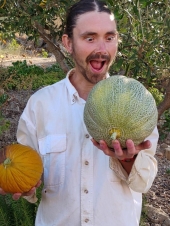posted 7 years ago
That sounds great.
What is the land like? What's on it now? Do you know what was grown on it in the past, and how (even when will give you an approximate idea)?
Are you looking to use animals? This is a big one, as it relates directly to the cycling of nutrients to make more soil. I know some people who do farm rescues, not for harvest, just to keep the land grazed, growing, and producing more soil.
When it rains, what does the water do on the land? One of the very first things many permies like to think about is the effect of water on the land. Hydrology is so powerful that it allows us to make at times radical changes with small physical adjustments, making moving water a force of creation; unchecked, it can wash everything away.
I would look at your sloping areas, if any, and just generally look for signs of erosion. Without getting too specific, you want to slow the water, put barriers across its downhill path to catch it and the sediment it carries, and encourage infiltration and sedimentation. These barriers can be hand-dug swales, or as simple as heavier woody debris and rocks laid out on contour.
If you are in the areas that can sometimes get many feet of snow, I would suggest you think about looking at your land in terms of shelter belts, and using productive understory within those shelter belts, like cane berries and maybe mulberry and small stonefruit trees, as snow fences in the winter, and as densely-treed spaces that will hold their snow into the spring, delaying the melt runoff and hydrating your land longer before the spring rains, and potentially holding off budding until killing frosts are through.
What do you want to grow? Are you looking to grow it for yourself and family, or for sale? Do you have any ideas about how you want to grow it?
If you are going to be growing food, I would think about things like pollinator habitat and food, butterfly gardens, that kind of thing. Getting any bare ground covered in, at very least, green manures, probably again with an eye to pollinator habitat and food, is really important for keeping soil in place. Putting these things in the path of water draining overland will trap sediment and encourage water infiltration, leading to more groundwater and less soil lost in the runoff.
What is the nature of the damage caused by the inlaws? Also, what are you thinking about the centre?
Not to drown you in questions or anything, just offering some leading points. I am also kind of really curious.
-CK
A human being should be able to change a diaper, plan an invasion, butcher a hog, conn a ship, design a building, write a sonnet, balance accounts, build a wall, set a bone, comfort the dying, take orders, give orders, cooperate, act alone, solve equations, analyze a new problem, pitch manure, program a computer, cook a tasty meal, fight efficiently, die gallantly. Specialization is for insects.
-Robert A. Heinlein

 5
5




 1
1




 2
2








 1
1












 1
1




 2
2

















